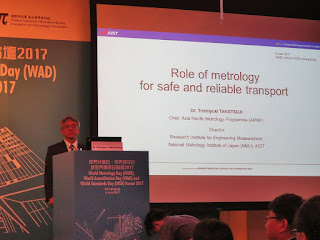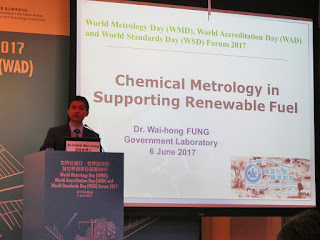The Hong Kong Council for Testing
and Certification (HKCTC), the Standards and Calibration Laboratory of the
Innovation and Technology Commission (SCL), Government Laboratory (GL), Hong
Kong Accreditation Service (HKAS) and Product Standards Information Bureau
(PSIB) jointly organized the World Metrology Day (WMD), the World Accreditation
Day (WAD) and the World Standards Day (WSD) Forum on 6 June 2017. Hong Kong Society for Quality (HKSQ) was one
of supporting organizations. This forum
aimed to celebrate the WMD, WAD and WSD and introduce to participants various
aspects and benefit of the quality infrastructure.
In the beginning, Ms. Annie CHOI
Suk-han, JP (Commissioner for Innovation and Technology, ITC, HKSAR Government)
gave welcoming remarks. She said quality
infrastructure that established and implemented standardization, metrology,
accreditation and conformity assessment services. A sound quality infrastructure is the cornerstone
of a smart, modern city. The she introduced
themes for the World Metrology Day (WMD), World Accreditation Day and World
Standards Day (WSD) forum below:
WMD: Measurements for Transport
WAD: Accreditation – Delivering
Confidence in Construction and the Built Environment
WSD: Standards Make Cities
Smarter
Then Dr. Della SIN Wai-mei, JP (Government Chemist, Government Laboratory, HKSAR Government) gave an opening remarks. She said the forum aimed to enhance deeper understand of quality infrastructure. She introduced today’s program that part 1 related to quality infrastructure to support smart city and part 2 for construction industry.
The first speaker was Dr.
Toshiyuki Takatsji (Chairperson, Asia Pacific Metrology Programme (APMP)) and
his topic entitled “Role of Metrology for Safe and Reliable Transport”. Firstly, he introduced Agency of Industrial
Science and Technology (AIST), which was a public research institute, and
National Metrology Institute of Japan (NMIJ).
Dr. Takatsji briefed the
unification of measuring units such as meter convention. Because of non-international unit employed,
many disunity accidents happened in the past such as Gimli Glider (1983), Mars
Climate Orbiter (1999), etc. Unification
of the units facilitated the international trade Dr. Takatsji said.
Then he introduced APMP which was
a group of national metrology institutes (NMIs) from Asia-Pacific region
engaged in improving regional metrological capability since 1977. He also introduced their national quality
infrastructure (NQI) included NMIJ, JISC and NITE under METI.
After that he quoted Lord Kelvin’s
famous words that “To measure is to know” & “If you cannot measure it, you
cannot improve it.” Moreover, he stated NMIJ
established ISO 16063-17 (Methods for the calibration of vibration and shock
transducers -- Part 17: Primary calibration by centrifuge) with collaborative
to automobile companies and published in 2016.
He also mentioned the emergency stop of Shinkansen Super Express in East
Japan Earthquake. Lastly, he concluded
that safe and reliable transportation was underpinned by metrology which played
indispensable role in establishing national quality infrastructure.
The second speaker was Ms. CHANG
Kwei-fern (Chairperson, Pacific Accreditation Cooperation (PAC)) and her topic
named “Accreditation in Supporting the Built Environment”. She introduced three related departments in
Singapore and they were Singapore Civil Defense Force (SCDF), Building and Construction
Authority (BCA) and Ministry of Manpower (MOM).
In the beginning, she introduced
four global trends in the built environment included “War for Talent”, “Sustainable
& Green Movement”, “Technologies Driving Innovation” and “Alternative
Building Methods”. Accreditation in the
Built Environment related management system certifications were ISO 14001 &
ISO 50001; Product certification based on ISO/IEC 17065, Soil Testing based on
ISO/IEC 17025 and coming new OHSMS ISO 45001.
Then Ms. Chang briefed the values
of accreditation included determining the technical competence, integrity and
impartiality, transparent and credible conformity assessment result, etc. For government and regulators, benefits were
reduce public resources with assurance, enable innovation of good practice and
build a more competitive economy, as well as, removal of technical barriers to
trade. For construction industry,
benefits were confidence of products and raw material, thus reducing potential
delays and product failure; Due diligence through independent evaluation and provided
safe working environment.
After that she mentioned about
Pacific Accreditation Cooperation (PAC) which was association of accreditation bodies
and other interested parties whose objective was to facilitate trade and commerce
among economies in the Asia Pacific region.
She also stated the world accreditation structure that IAF/ILAC is
international and then PAC/APLAC, EA, IAAC were regional. Finally, Ms. Chang concluded her talk using the
Quality Ecosystem linked with all stakeholders.
The third speaker was Mr. Adrian
O’CONNELL (Chairperson, Pacific Area Standards Congress (PASC)) and his
presentation title was “Standards Making Cities Smarter – Recent Initiatives”. Firstly, he introduced PASC which was a forum
of Pacific Rim countries to strengthen international standardization programs
in the region and support free trade, economic efficiency and development in
the region.
Then he mentioned one of
definition on Smart Cities: “A smart sustainable city is an innovative city
that uses information and communication technologies (ICTs) and other means to
improve quality of life, efficiency of urban operation and services, and
competitiveness, while ensuring that it meets the needs of present and future
generations with respect to economic, social and environmental aspects”.
Mr. O’connell mentioned ICT such
as IoT and Big data were smart cities enablers. Other enablers were Energy and
Infrastructure, Standards, etc. ISO and
IEC standards supported smart cities such as Blockchain standards (Australia
& ISO/TC 307), Energy Transition (IEC TC 13 & IEC 62619), IoT (IEC
& ISO: ISO/IEC JTC 1/SC 41; ISO/IEC 30141) and Sustainable Development (ISO
37101).
Q&A Session 1.
During the tea break, I met my
friend Ms. Brenda Lam (Senior Engineer, SCL) and we took a photo for memory.
Ir. Dr. Mckey Ho (Senior
Professional (Components & Materials, Hong Kong Housing Authority) was the
fourth speaker and his topic entitled “Third-party Certification and Testing –
the Hong Kong Housing Authority’s Experience”.
Firstly, he introduced HA and their quality journey.
Then Dr. Ho briefed their quality assurance and process management since 1987 from inspection to QC. And then they certified ISO 9001 since 1994 from QC to QA, as well as, form QA to QM. He said it was expected to be updated the ISO 9001:2015 certification within 2017. Until now, HA had been certified ISO 9001:2008, ISO 14001:2004, HKQAA CSR Index, ISO 50001:2011 and OHSAS 18001:2007. Dr. Ho told us that they adopted EFQM model for system integration since 2011.
After that Dr. Ho introduced
their QC mechanism throughout the Procurement Cycle. The performance-based controlling mechanism
for works contracts included four steps below.
1. Selection of Tenderers & List
Management
2. Tendering & Tender Evaluation
3. Performance Monitoring
(Performance Assessment Scoring System – PASS)
4. Contract Migration & Review
(KPIs)
Dr. Ho showed the table that
different contractors had different certification requirements. For direct testing contractors (testing
laboratories) on main construction material requested to be accredited under
HOKLAS in HA Specification, as well as, ISO 14001 and OHSAS 18001 certified. At the end, Dr. Ho told us about sustainable
products through both Downstream and Upstream controls. Downstream control was based on valid test
certificates issued by HOKLAS accredited laboratories and surveillance test
upon material delivery. Upstream control
was based on manufacturers certified to ISO 9001, ISO 14001 and OHSAS 18001, as
well as, product certification (2010/2011 for 10 major building materials).
Dr. Wai-hong FUNG (Senior Chemist (Strategic Development Section), Government Laboratory) was the fifth speaker and his presentation title was “Chemical Metrology in Supporting Renewable Fuel”. In the beginning, Dr. Fung briefed the relationship between energy and transport that liquid fuels were dominant source for transportation energy consumption.
Since fossil energy was
non-renewable which would increase global warming and not sustainable, biofuels
was an important alternative energy sources for transport because it was
renewable, less impact on current infrastructure. The most common biofuels were bio-ethanol
(E10, E15, E25, E85, E100) and biodiesel (B2, B5,B20, B100).
About Biofuels quality issues
such as impurities which affected engine parts to induce corrosion and
oxidation. In USA, some specifications
of biofuels governed by standards such as ASTM D4806, D5798, D6751 and
D7467. In Europe, they were EN 14214 and
EN 15376.
There were different testing
methods for biofuel test under ASTM and EN specification and showed in the
following table.
Finally, Dr. Fung briefed the
chemical metrology on developing reference methods and traceable measurements for
biofuel. He also mentioned Consultative
Committee for Amount of Substance (CCQM) of BIPM schemes for biofuel such as
CCQM-P129 “Determination of Ethanol and Water in Bio-ethanol Fuel”, CCQM-K100 “Analysis
of Copper in Bio-ethanol” and CCQM-K123/P157 “Trace Elements in Biodiesel”. At the end, he stated some CRM for Biofuels
below.
For NIST (USA), SRM 2772 B100
Biodiesel (Soy-based) and SRM 2773 B100 Biodiesel (Animal-based)
For IRMM (European Commission), ERM-EF001
Biodiesel (Rapeseed)
For NMIJ (Japan), CRM 8301-a
Bioethanol and CRM 8302-a Biodiesel Fuel (Palm Oil-based)
Mr. YAN Yui-kuen (Head of
Laboratory, SCL) was the last speaker and his topic named “Metrology Supports
Modern Transport”. In the beginning, Mr.
Yan told us his dream on transportation like teleportation in Star Wars. Then he pointed out some desired transport
system elements.
And then Mr. Yan analyzed modern
transportation features as follows:
-
Space (High-tech, expensive and need a special training)
-
Air (Fast, expensive, limited capacity, airports needed)
-
Land (Relatively inexpensive, large amount of goods & people, many
forms & speed)
-
Sea (Slow, inexpensive, large capacity and energy efficient)
Finally, he discussed the smart
transportation.
Lastly, Mr. Yan said different
transportation had measurement needs such as dimensions, mechanical,
electrical, time, etc. SCL could also
provide such service.
Q&A Session 2.
Reference:
Seminar
on the WMD, the WAD and the WSD 2016 (flyer) - http://www.itc.gov.hk/en/quality/hkas/images/Photos/World_Accreditation_Day/WAD_2016_flyer.pdf
Seminar
Celebrating the WMD, the WAD and the WSD 2015 - https://qualityalchemist.blogspot.hk/2015/05/seminar-celebrating-wmd-wad-and-wsd-2015.html
Seminar
Celebrating the WMD, the WAD and the WSD 2014 - http://qualityalchemist.blogspot.hk/2014/05/seminar-celebrating-wmd-wad-and-wsd-2014.html
World
Metrology Day 2013 Seminar - http://qualityalchemist.blogspot.hk/2013/05/world-metrology-day-2013-seminar.html
World
Metrology Day 2012 Seminar - http://qualityalchemist.blogspot.hk/2012/05/world-metrology-day-2012-seminar.html
World
Accreditation Day 2012 Seminar - http://qualityalchemist.blogspot.hk/2012/06/world-accreditation-day-2012-seminar.html


























沒有留言:
發佈留言